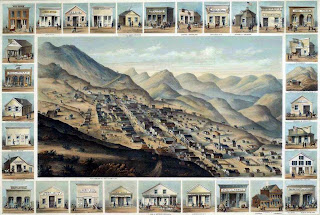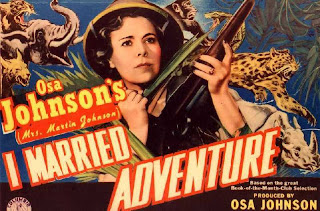When I was in College, I bought a strikingly-bound book called "I Married Adventure" in a second hand store. It was written by Osa Johnson, a young Kansan woman who accompanied her husband, Martin on a series of adventures in Borneo, Africa and the Soloman Islands early in the last century. Besides being an author, Osa and Martin were early filmmakers, naturalists and photographers. For decades this dashing couple captured the public's imagination through their films and books of adventure in exotic, far-away lands.
The Martins studied the wildlife and peoples of East and Central Africa, the South Pacific Islands and British North Borneo. They explored then-unknown lands and brought back film footage and photographs, offering many Americans their first understanding of these distant lands.
Living for months at a time in the bush, the Martins often adopted monkeys for pets.
The Crew For a Trip From Nairobi Into The Congo.
The movies and photos the Martins brought back were often the first view that Americans had of these primitive peoples.
The 1940 film was released simultaneously with the book.
Osa was no slouch with a firearm, The Martins often had to face down wild animals trying to get the most exciting shots with their cameras.
Back at their Nairobi home, Osa shares ice cubes with the natives.
When Osa married she understood that Martin was not likely to provide a "normal" home life but she probably had no idea how different her life would be from other Kansas farmgirls. Even in the remotest parts of Africa she still made sure their safari suits were freshly-laundered and ironed.
The 1932 feature movie Congorilla resulted from the couple's fourth trip to Africa, and was the first movie with sound authentically recorded on the continent.
Osa with another pet.
Osa and Martin with two of their cameras.
Although their early expeditions were poorly funded and they travelled meagerly, as they made more money from their films, they were able to go in style later on. Martin designed this special filming safari vehicle for use on their third African trip.
"Home Sweet Home"
In 1932 the Johnsons learned to fly at the airfield in Osa's hometown of Chanute. Once they had their pilot's licenses, they purchased two Sikorsky amphibious planes, a S-39-CS "Spirit of Africa" and S-38-BS "Osa's Ark".
Osa at the controls.

























































